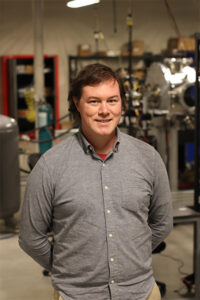Brett Compton, associate professor in UT’s Department of Mechanical, Aerospace and Biomedical Engineering, recently had his work on 3D-printed composites published in two journals and one of those publications was chosen as an “Editor’s Choice” article, adding an extra level of achievement to his research.

Compton’s paper entitled, “Size effects in 3D-printed polymer-derived, zirconium diboride-reinforced ceramic composites,” was one of eleven manuscripts selected as a finalist for the inaugural Journal of the American Ceramic Society 2nd Century Trailblazers initiative and was published in a special issue of the journal as an “Editor’s Choice” article, signifying the editor’s recognition of excellence.
This work provides insight into the nature and cause of flaws that arise during the printing and processing of polymer-derived ceramic composites and suggests a new formulation approach that can help reduce flaws and enable larger components to be fabricated successfully. Polymer-derived ceramic composites have great potential for use in high-temperature applications like high-speed flight or power generation.
Compton’s second paper entitled, “High through-thickness thermal conductivity of 3D-printed composites via rotational direct ink writing,” was published in Additive Manufacturing Letters. The work presented in this paper shows for the first time that the thermal conductivity of 3D-printed composite materials can be increased by up to 40 percent in the build direction (perpendicular to the printed layers) using a special technique called Rotational Direct Ink Writing with a carbon fiber-reinforced epoxy system. This technology is something Compton invented during his time as a post-doc at Harvard University and is one of very few technologies available that can effectively reorient the fibers of a printed composite during the printing process.
“I’m very excited to have these works published,” said Compton. “The publications represent two related, but distinct aspects of the work we do in the group: novel material formulation and novel hardware to exercise greater control over material architecture. Both efforts result in printed objects with better properties that can be more precisely tuned for specific applications. The work in Additive Manufacturing Letters, in particular, showcases a unique and highly promising route to improve thermal properties of printed composites that could find application in leading edges, heat exchangers, brake discs, or cutting tools.”
Contact
Kathy Williams, williamk@utk.edu